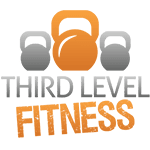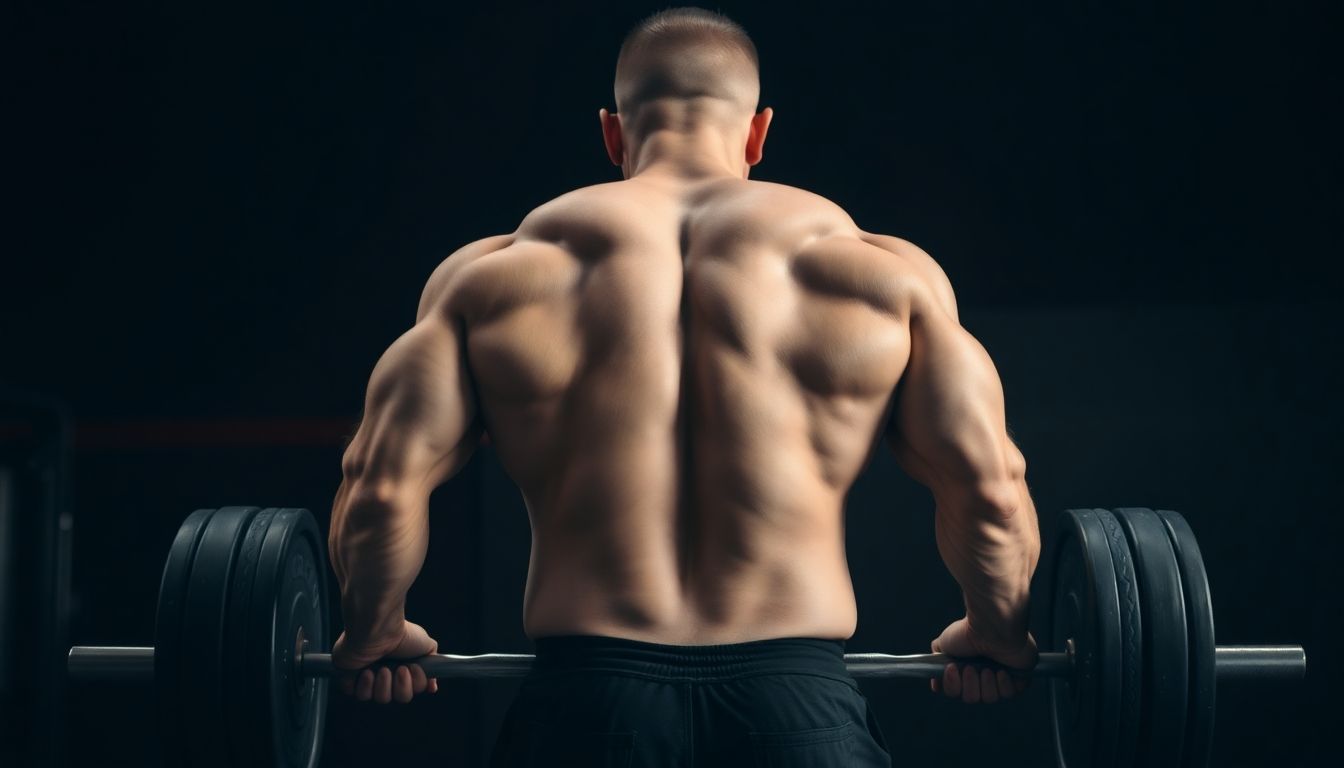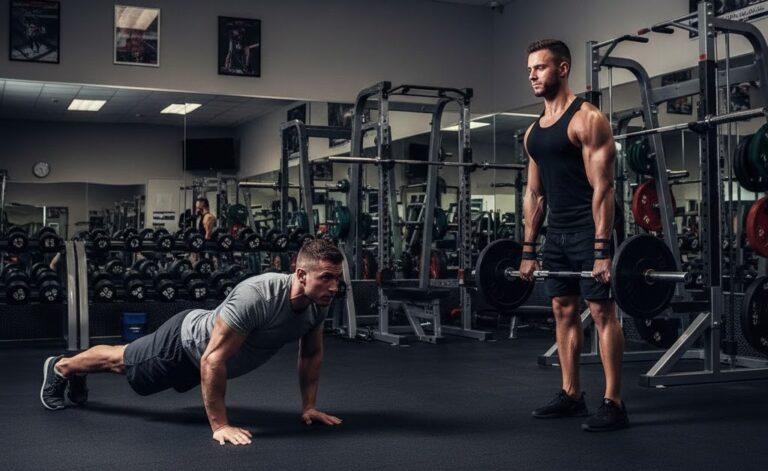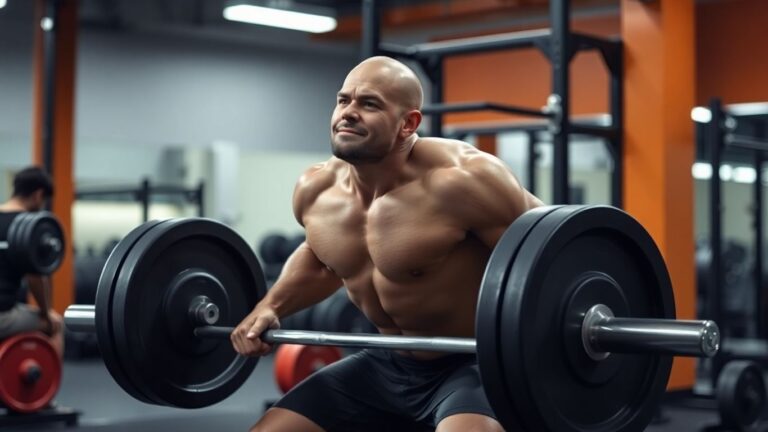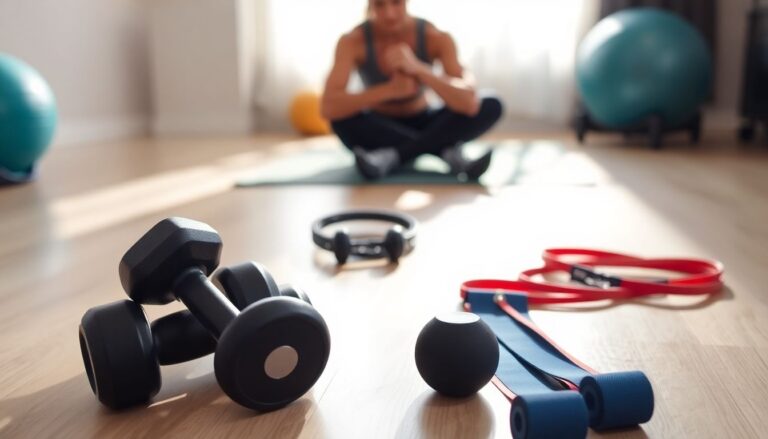So, you’re looking to get stronger, build some serious muscle, or maybe just have more energy for your day-to-day life. Hitting the gym regularly is a fantastic way to do that, but sometimes it’s hard to know where to start. There are tons of different approaches to working out, and figuring out the best Gym Workouts and Training Routines for your goals can feel a bit overwhelming. Don’t worry, though! We’re going to break down some of the most effective ways to structure your gym sessions to help you get the results you’re after.
Key Takeaways
- To build muscle, aim to train each muscle group at least two to three times per week. This can be done with 3-6 gym sessions weekly.
- Focus on compound exercises like squats, deadlifts, and presses, as they work multiple muscles at once. Add isolation exercises to target specific muscles.
- Progressive overload is key. Gradually increase the weight, reps, or difficulty over time to keep challenging your muscles and promoting growth.
- Rest and recovery are just as important as training. Schedule rest days to allow your muscles to repair and grow stronger.
- Nutrition plays a big role. Eating enough protein and being in a slight calorie surplus generally helps with muscle gain, while a calorie deficit with high protein can help build muscle while losing fat.
1. Push, Pull, Legs Workout Split
Alright, let’s talk about the Push, Pull, Legs (PPL) split. This is a super popular way to organize your gym time, especially if you’re past the beginner stage and looking to pack on some muscle or get stronger. The idea is pretty straightforward: you divide your week into three types of workouts based on the movement pattern.
On ‘Push’ days, you’re hitting all the muscles involved in pushing movements. Think chest, shoulders, and triceps. Exercises like bench presses, overhead presses, and dips fall into this category. It’s a great way to give these muscle groups a focused blast.
Then you have ‘Pull’ days. This is all about the muscles that help you pull things towards you. We’re talking about your back and biceps here. Deadlifts, pull-ups, rows, and bicep curls are your go-to exercises for these days. You’ll really feel your back muscles working.
Finally, ‘Legs’ day. This one’s pretty self-explanatory – it’s all about your lower body. Squats, lunges, hamstring curls, and calf raises will be on the menu. Don’t skip leg day; it’s a huge part of building overall strength and a balanced physique.
The beauty of the PPL split is that it allows for good recovery because you’re not hitting the same muscle groups on consecutive days. This means your muscles have time to repair and grow before you train them again. It’s a solid choice for intermediate lifters who want to increase their training volume and see some serious gains. You can run this split in a few ways, like three days on and one day off, or even a six-day cycle if you’re really committed. It’s a really effective way to structure your training, and you can find plenty of resources on how to program it for your specific goals, like this guide on weightlifting fundamentals.
Here’s a quick look at how a typical PPL week might shape up:
- Day 1: Push (Chest, Shoulders, Triceps)
- Day 2: Pull (Back, Biceps)
- Day 3: Legs (Quads, Hamstrings, Glutes, Calves)
- Day 4: Rest
And then you repeat the cycle. It’s a simple yet effective system that many people swear by for building strength and muscle.
2. Full Body Workout Split
If you’re new to the gym or just really short on time, a full body workout split might be your best bet. The idea here is pretty simple: you hit all the major muscle groups in one session. This means you’re not spending hours in the gym, and it’s great for getting a solid foundation. You can usually get away with doing this 2 or 3 days a week, which leaves plenty of room for rest or other activities.
This split is fantastic because it prioritizes compound exercises, which are those awesome moves that work multiple muscles at once, like squats, deadlifts, and presses. Not only does this help build overall strength and muscle, but it’s also super time-efficient. Plus, since you’re working everything each session, if you miss a day, it’s not the end of the world for a specific muscle group.
Here’s a sample of how a 3-day full body split could look:
- Monday: Full Body Workout
- Tuesday: Rest
- Wednesday: Full Body Workout
- Thursday: Rest
- Friday: Full Body Workout
- Saturday: Rest
- Sunday: Rest
One of the cool side effects of hitting multiple muscle groups and doing those big compound lifts is that you’ll likely burn more calories. This can be a nice bonus if you’re also looking to manage your weight. It’s a really practical way to train, especially when you’re just starting out or trying to fit workouts into a busy schedule. You can find more info on how to structure your training at your gym goals.
While it’s efficient, make sure you’re not accidentally neglecting certain muscles. It’s easy to focus on the exercises you like or are good at. Pay attention to hitting everything, or you might end up with imbalances down the line.
3. Upper Lower Split Workout
Alright, let’s talk about the Upper Lower split. This is a really popular way to organize your gym time, and for good reason. It’s straightforward and works well for a lot of people, especially if you’re aiming to build strength. The basic idea is simple: you dedicate one day to training your upper body muscles and the next day to your lower body. Then you repeat.
This split is fantastic for hitting each major muscle group twice a week, which is often considered optimal for muscle growth and strength gains. It gives you enough time in each session to really focus on those big, compound lifts that build a solid foundation, but also leaves room for some accessory work to target specific areas.
Here’s a common way to structure it over four days:
- Day 1: Upper Body (Chest, Back, Shoulders, Biceps, Triceps)
- Day 2: Lower Body (Quads, Hamstrings, Glutes, Calves)
- Day 3: Rest or Active Recovery (Light cardio, stretching, or just a break)
- Day 4: Upper Body
- Day 5: Lower Body
- Day 6 & 7: Rest
One of the biggest perks of this split is how flexible it is. You can adjust it based on how many days you can commit to the gym. Whether you do it 2, 3, 4, or even 6 days a week, it can be effective. Studies suggest that a 4-day split can be just as good for building muscle and strength as a 6-day split, while giving your body more time to recover. This extra recovery time is super important for preventing burnout and staying injury-free. Plus, having those rest days means you can also fit in other activities you enjoy, like cardio or conditioning without feeling totally wiped out.
While the Upper Lower split is great for strength, you do need to be a bit mindful. Without a solid plan, it’s possible to accidentally skip over certain smaller muscle groups or overwork others. This could lead to imbalances down the line, so make sure you’re covering all your bases when you plan your workouts.
It’s a solid choice for many lifters because it balances frequency, recovery, and the ability to focus on heavy lifting. You get that good stimulus for growth without completely wrecking yourself every single day.
4. Body Part Workout Split
Alright, let’s talk about the Body Part Workout Split. This is the classic approach, often called the ‘Bro Split’ by some, where you dedicate each gym day to a specific muscle group or two. Think Monday for chest, Tuesday for back, and so on. The idea here is to give one muscle group a ton of attention and volume in a single session, then let it chill out for the rest of the week to recover and grow.
This split is really popular if your main goal is hypertrophy, or building muscle size. Because you’re focusing all your energy on just one or two areas, you can really push them hard with lots of sets and reps. It also means you get plenty of rest for each muscle group before you hit it again, which can be good for preventing burnout and injury.
Here’s a peek at how a typical week might look:
- Monday: Chest and Triceps
- Tuesday: Back and Biceps
- Wednesday: Legs (Quads, Hamstrings, Calves)
- Thursday: Shoulders and Abs
- Friday: Rest or Active Recovery
- Saturday: Rest
- Sunday: Rest
Now, while this split can be great for targeting specific muscles and getting a good pump, it’s worth noting that some people find they don’t hit each muscle group frequently enough for optimal growth. Modern thinking often suggests hitting muscles more than once a week. However, if you love the feeling of completely annihilating a muscle group and then having a full week to recover, this split might just be your jam. It’s all about finding what works best for your body and your schedule.
5. Barbell Bench Press
Alright, let’s talk about the barbell bench press. This is a classic for a reason, seriously. It’s one of the best exercises you can do for building up your chest, shoulders, and triceps. If you’re looking to build serious upper body pushing strength, this is your go-to move.
When you’re setting up, lie flat on a bench with your feet planted firmly on the floor. Grab the barbell with an overhand grip, a bit wider than shoulder-width apart. You want to unrack the bar and hold it straight over your chest with your arms locked out. Then, slowly lower the bar down towards your mid-chest. Keep those elbows tucked in a bit, around a 45-degree angle from your body – don’t let them flare straight out to the sides. Once the bar lightly touches your chest, pause for a second, and then press it back up explosively to the starting position. Remember to exhale as you push up.
Here’s a quick rundown of how to approach it:
- Grip Width: Experiment a little, but generally, a grip slightly wider than shoulder-width is good for most people. Too wide can put stress on your shoulders, and too narrow might not hit your chest as effectively.
- Bar Path: Aim to lower the bar to your lower chest or upper abdomen area. The bar path isn’t a straight up-and-down line; it’s more of a slight arc as you press it back up and slightly back over your shoulders.
- Leg Drive: Don’t forget your legs! Driving your feet into the floor can help you generate more power and stability throughout the lift.
This exercise is fantastic for building overall upper body mass and strength. Just make sure you’re using good form to get the most out of it and stay safe.
6. Barbell Deadlifts
Alright, let’s talk about the deadlift. This is one of those exercises that people either love or hate, but there’s no denying its power for building overall strength. It’s a true test of your might, working pretty much everything from your legs and back to your grip.
When you’re doing deadlifts, you’re essentially picking a weight up off the floor until you’re standing tall. Sounds simple, right? But getting the form just right is super important to avoid any ouchies.
Here’s a basic rundown of how to tackle a barbell deadlift:
- Setup: Stand with your feet about hip-width apart, with the barbell over the middle of your feet. Hinge at your hips and bend your knees to grab the bar with an overhand or mixed grip, hands just outside your shins. Make sure your back is straight, chest is up, and your shoulders are pulled back.
- The Pull: Take a deep breath, brace your core, and drive through your heels. Keep the bar close to your body as you stand up, extending your hips and knees. Think about pushing the floor away from you.
- Lockout: Once you’re standing tall, don’t lean back too far. Just stand straight with your shoulders back. Then, lower the bar back down with control, reversing the motion.
The deadlift is often called the ‘king of exercises’ for a reason. It hits so many muscles at once, making it incredibly efficient for building strength and muscle mass.
Remember, form is king here. It’s way better to lift a lighter weight with perfect form than to try and ego-lift a heavy weight and risk injury. Start light, focus on technique, and gradually increase the weight as you get more comfortable and confident.
7. Barbell Military Press
Alright, let’s talk about the Barbell Military Press. This is a fantastic exercise for building up your shoulders, and honestly, your whole upper body. It’s a bit of a beast, but totally worth it.
The military press is a compound movement that works multiple muscle groups at once, making it super efficient for strength and size. You’re hitting your deltoids (that’s your shoulder muscles), your triceps, and even your upper chest and core are getting a workout trying to keep you stable.
Here’s a quick rundown on how to do it right:
- Setup: Stand with your feet about shoulder-width apart, with the barbell resting on your upper chest and shoulders. Grip the bar slightly wider than shoulder-width. Brace your core – this is important!
- The Press: Press the barbell straight up overhead until your arms are fully extended. Keep your head and neck neutral, looking straight ahead.
- The Lower: Slowly lower the bar back down to your starting position with control. Don’t just let it drop!
It’s a good idea to start with lighter weights to really nail the form. Getting the technique down is way more important than just throwing heavy weight around, especially when you’re starting out. You can find some great beginner tips on strength training.
Remember, consistency is key. Aim to include this in your routine a couple of times a week, allowing for rest days in between so your muscles can recover and grow. Don’t be afraid to adjust the weight as you get stronger; that’s how you keep making progress.
This exercise is a real test of your upper body strength. If you’re looking to build serious shoulder power, the military press is definitely one to have in your arsenal.
8. Barbell Bent Over Rows
Alright, let’s talk about the barbell bent-over row. This is a seriously solid exercise for building up your back, especially the lats and rhomboids, and it also hits your hamstrings and glutes as stabilizers. It’s a compound movement, meaning it works multiple muscle groups at once, which is super efficient for building overall strength and muscle.
To do it right, start by standing with your feet about hip-width apart, holding a barbell with an overhand grip, hands a bit wider than shoulder-width. Now, hinge at your hips, keeping your back straight – think about pushing your butt back like you’re closing a car door. Your torso should be almost parallel to the floor. Let the barbell hang straight down with your arms extended. From here, pull the barbell up towards your lower chest or upper abdomen, squeezing your shoulder blades together at the top. Keep your elbows tucked in close to your body. Slowly lower the weight back down with control. The key is to maintain a rigid torso and avoid using momentum to swing the weight up.
Here’s a quick breakdown:
- Starting Position: Feet hip-width, slight knee bend, back straight, torso near parallel to the floor, barbell hanging.
- The Pull: Pull the bar towards your lower chest/upper abs, squeezing shoulder blades.
- The Lower: Control the descent back to the starting position.
When you’re setting up, make sure you’re not rounding your back. That’s a fast track to injury. Engaging your core is super important here to keep everything stable. You want to feel the pull coming from your back muscles, not just your arms. It’s a movement that really helps build that thick, strong back that looks good and functions well. If you’re looking for a gym that has all the equipment you need to master exercises like this, check out Clayton Fitness NC.
Proper form is way more important than lifting heavy here, especially when you’re starting out. Focus on feeling the muscles work and gradually increase the weight as you get stronger and more comfortable with the movement.
9. Barbell Squats
Alright, let’s talk about the king of lower body exercises: the barbell squat. Seriously, if you’re looking to build some serious leg muscle and overall strength, this is the move. It hits your quads, hamstrings, glutes, and even your core. It’s a compound movement, meaning it works multiple muscle groups at once, which is super efficient for building muscle and strength.
Getting the form right is super important here, so don’t rush it.
Here’s a quick rundown on how to do a basic barbell back squat:
- Setup: Place the barbell on your upper back, just below your neck, resting on your traps. Grip the bar wider than shoulder-width.
- Unrack: Take a deep breath, brace your core, and stand up to unrack the weight. Take a small step back.
- The Descent: Feet should be about shoulder-width apart, toes pointed slightly out. Keep your chest up and your back straight. Lower yourself down by pushing your hips back and bending your knees, as if you’re sitting into a chair. Go as low as you comfortably can, ideally until your thighs are at least parallel to the floor.
- The Ascent: Drive through your heels and midfoot to stand back up, keeping your chest up and core tight. Squeeze your glutes at the top.
It might seem simple, but mastering the squat takes practice. You’ll want to focus on progressive overload, meaning you gradually increase the weight, reps, or sets over time to keep challenging your muscles. This is a key part of any effective fitness journey.
Remember, consistency is key. Even if you’re not lifting super heavy weights at first, doing squats regularly will build a solid foundation for your lower body strength and muscle growth. Don’t be afraid to start with lighter weights or even just the bar to get the movement down.
When you’re starting out, you might want to focus on mastering the squat with just the barbell before adding significant weight. As you get more comfortable, you can start increasing the load. Aim for a rep range that suits your goals, but for building muscle and strength, something in the 5-10 rep range is often a good starting point. Just make sure you’re not sacrificing form for more weight. It’s better to lift a little less and do it right than to risk injury.
10. Dumbbell Incline Press and more
Alright, let’s talk about the dumbbell incline press. This is a fantastic move for hitting that upper chest area, giving it a nice, full look. You’ll want to set yourself up on a bench that’s angled between 30 and 45 degrees. Grab a pair of dumbbells and sit on the edge of the bench, with the weights resting on your knees. Then, lean back, bringing the dumbbells up so they’re over your chest, feet planted firmly on the floor. Keep your core tight and your arms extended, ready to go.
The key is to control the movement. Lower the dumbbells slowly, letting your elbows flare out a bit, aiming for a good stretch across your chest. Don’t just let them drop! Once you feel that stretch, push them back up explosively, squeezing your chest muscles at the top. You’re looking for about 12 reps here, and remember to keep those shoulder blades pulled back.
After you’ve crushed your incline presses, you might want to add in some dumbbell flyes on the same incline bench. Use lighter weights for this one. With palms facing each other, lower the dumbbells out to your sides, feeling a stretch in your chest. Bring them back together, focusing on that squeeze. This really helps to isolate the chest muscles.
Here’s a quick rundown of how you might structure a chest day focusing on these moves:
- Incline Dumbbell Press: 3-4 sets of 10-12 reps
- Incline Dumbbell Flyes: 3 sets of 12-15 reps
- Flat Dumbbell Press: 3 sets of 10-12 reps
- Dumbbell Pullovers: 3 sets of 12-15 reps
Working with dumbbells gives you a great range of motion and helps to build stabilizer muscles that barbells sometimes miss. Plus, they’re super versatile for all sorts of exercises.
Don’t forget to warm up properly before you start, and always focus on your form over lifting super heavy weights, especially when you’re starting out. You can find more great dumbbell exercises on this page if you’re looking to mix things up.
Wrapping It Up: Your Path to a Stronger You
So, we’ve gone over a bunch of ways to build muscle, get stronger, and boost your endurance. Remember, the key things are to stick with it, challenge yourself a little each time, and give your body the fuel and rest it needs to grow. Don’t get discouraged if you don’t see huge changes overnight; real progress takes time and consistency. Pick a plan that feels right for you, focus on good form, and celebrate the small wins along the way. You’ve got this!
Frequently Asked Questions
How often should I work out to build muscle?
To see your muscles grow and change, you should aim to work each muscle group at least two or three times each week. This means going to the gym at least twice a week, but you can go up to six times. Remember, rest days are super important for muscles to repair and get bigger.
What’s the difference between a plan for gaining muscle and one for losing fat?
A muscle-gaining plan focuses on getting bigger and stronger, usually with tough resistance exercises and eating a bit more calories than your body needs. A fat-loss plan is all about shedding pounds, often mixing exercises with less food. The exercises might be similar, but how you eat, rest, and push yourself changes depending on what you want to achieve.
Do I really need protein shakes or supplements to get bigger muscles?
Not necessarily! You can definitely build muscle with just good food, enough rest, and consistent workouts. Supplements like whey protein or creatine can be helpful if you’re not getting enough nutrients from your diet, but they aren’t magic pills. Think of them as extra help, not the main event.
What if I miss a workout day?
Don’t sweat it! Life happens. If you miss a day, just adjust your schedule for the week or pick up where you left off. The most important thing is to stick with your routine over time, not to be perfect every single day.
How long does it take to see results from working out?
Building muscle takes patience and consistency. You might start noticing changes in strength within a few weeks, but visible muscle growth typically takes at least 6 to 12 weeks of regular training. Keep at it, and you’ll get there!
Can I build muscle and lose fat at the same time?
Yes, it’s possible, especially if you’re new to working out or haven’t trained in a while! This is sometimes called ‘body recomposition.’ You’ll need to eat plenty of protein, lift weights regularly, and eat just a little less than your body needs. It might take a bit longer than focusing on just one goal, but it’s a great way to change your body shape and get fitter.
